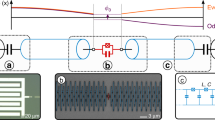Abstract
One of the most important paradigms of quantum computation rests on employing the Cooper pair condensate states in a Josephson junction. In using these, the configuration of great current interest is the \(0\)–\(\pi\) qubit. We present the linear response of this to an external drive by solving the Liouville equation for the phase-space distribution function. Thus, we obtain “Ohm’s law” or the expression for electrical conductivity for this system in terms of novel correlation functions. This general result has been tested for the \(0\)–\(\pi\) qubit parameters that are used in recent experiments.


Similar content being viewed by others
References
A. A. Clerk, M. H. Devoret, S. M. Girvin, F. Marquardt, and R. J. Schoelkopf, “Introduction to quantum noise, measurement, and amplification,” Rev. Modern Phys., 82, 1155–1208 (2010).
P. W. Shor, “Fault-tolerant quantum computation,” in: Proceedings of 37th Conference on Foundations of Computer Science (Burlington, VT, USA, 14–16 October, 1996), IEEE Comput. Soc. Press, Los Alamitos, CA (1996), pp. 56–65; arXiv: quant-ph/9605011.
A. Yu. Kitaev, A. H. Shen, and M. N. Vyalyi, Classical and Quantum Computation (Graduate Studies in Mathematics, Vol. 47), Amer. Math. Soc., Providence, RI (2002).
S. McArdle, S. Endo, A. Aspuru-Guzik, S. C. Benjamin, and X. Yuan, “Quantum computational chemistry,” Rev. Modern Phys., 92, 015003, 51 pp. (2020).
S. Jain, R. Sehgal, and R. V. Jayaram, “Quantum computation – a sign of quantum supremacy,” Bombay Technologist, 68, 6 (2021).
R. Kubo, “Statistical-mechanical theory of irreversible processes. I: General theory and simple applications to magnetic and conduction problems,” J. Phys. Soc. Japan, 12, 570–586 (1957).
J. R. Dorfman, An Introduction to Chaos in Nonequilibrium Statistical Mechanics, (Cambridge Lecture Notes in Physics, Vol. 14), Cambridge Univ. Press, Cambridge (1999).
E. Helfand, “Transport coefficients from dissipation in a canonical ensemble,” Phys. Rev., 119, 1–9 (1960).
P. C. Martin, Measurements and Correlation Functions, Gordon and Breach, New York (1968).
D. A. McQuarrie, Statistical Mechanics, Harper & Row, New York (1976).
X.-G. Wen, Quantum Field Theory of Many-Body Systems, Oxford Univ. Press, Oxford (2004).
A. Kitaev, “Protected qubit based on a superconducting current mirror,” arXiv: cond-mat/0609441.
S. R. Jain and A. K. Pati, “Adiabatic geometric phases and response functions,” Phys. Rev. Lett., 80, 650–653 (1998); arXiv: chao-dyn/9804037.
P. Brooks, A. Kitaev, and J. Preskill, “Protected gates for superconducting qubits,” Phys. Rev. A, 87, 052306, 26 pp. (2013); arXiv: 1302.4122.
P. Krantz, M. Kjaergaard, F. Yan, T. P. Orlando, S. Gustavsson, and W. D. Oliver, “A quantum engineer’s guide to superconducting qubits,” Appl. Phys. Rev., 6, 021318, 57 pp. (2019).
R. K. Saini, R. Sehgal, and S. R. Jain, “Protection of qubits by nonlinear resonances,” Eur. Phys. J. Plus, 137, 356 (2022); arXiv: 2011.10329.
A. J. Lichtenberg and M. A. Lieberman, Regular and Stochastic Motion, (Applied Mathematical Sciences, Vol. 38), Springer, New York (1983).
S. R. Jain and R. Samajdar, “Nodal portraits of quantum billiards: Domains, lines, and statistics,” Rev. Modern Phys., 89, 045005, 66 pp. (2017); arXiv: 1709.03650.
N. Wax (ed.), Selected Papers on Noise and Stochastic Processes, Dover, New York (2017).
J. M. Dempster, B. Fu, D. G. Ferguson, D. I. Schuster, and J. Koch, “Understanding degenerate ground states of a protected quantum circuit in the presence of disorder,” Phys. Rev. B, 90, 094518, 12 pp. (2014); arXiv: 1402.7310.
G. Rajpoot, K. Kumari, S. Joshi, and S. R. Jain, “The tunable \(0\)–\(\pi\) qubit: Dynamics and relaxation,” Internat. J. Quantum Inf., 20, 2150032, 19 pp. (2022).
X. You, J. A. Sauls, and J. Koch, “Circuit quantization in the presence of time-dependent external flux,” Phys. Rev. B, 99, 174512, 10 pp. (2019); arXiv: 1902.04734.
M. H. Devoret, “Quantum fluctuations in electrical circuits,” in: Symmétries quantiques [Quantum Symmetries] (Proceedings of the Les Houches Summer School, Session LXIII, Les Houches, France, June 27 – July 28, 1995, S. Reynaud, E. Giacobino, and J. Zinn-Justin, eds.), Elsevier, Amsterdam (1996), pp. 351–386.
U. Vool and M. Devoret, “Introduction to quantum electromagnetic circuits,” Internat. J. Circuit Theory Appl., 45, 897–934 (2017).
D. K. Weiss, A. C. Y. Li, D. G. Ferguson, and J. Koch, “Spectrum and coherence properties of the current-mirror qubit,” Phys. Rev. B, 100, 224507, 17 pp. (2019); arXiv: 1908.04615.
D. J. Tannor, Introduction to Quantum Mechanics: A Time-Dependent Perspective, Univ. Sci. Books, Sausilito, CA (2007).
Author information
Authors and Affiliations
Corresponding author
Ethics declarations
The authors declare no conflicts of interest.
Additional information
Prepared from an English manuscript submitted by the author; for the Russian version, see Teoreticheskaya i Matematicheskaya Fizika, 2022, Vol. 213, pp. 482–494 https://doi.org/10.4213/tmf10305.
Appendix: Kinetic energy part of Hamiltonian
The gauge invariant kinetic energy term of the circuit of the \(0\)–\(\pi\) qubit with the effect of a time-dependent external flux can be calculated as [22]
Rights and permissions
About this article
Cite this article
Rajpoot, G., Kumari, K., Joshi, S. et al. Green–Kubo formula for electrical conductivity of a driven \(0\)–\(\pi\) qubit. Theor Math Phys 213, 1727–1737 (2022). https://doi.org/10.1134/S0040577922120066
Received:
Revised:
Accepted:
Published:
Issue Date:
DOI: https://doi.org/10.1134/S0040577922120066




